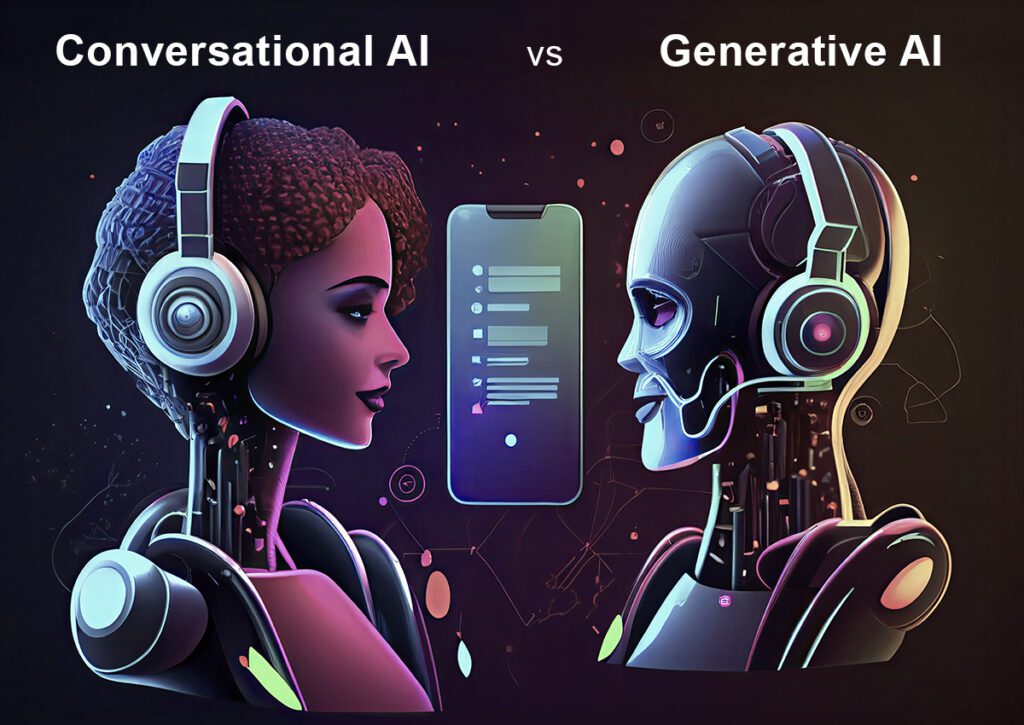Conversational AI, also known as chatbot or virtual assistant technology, has been rapidly gaining popularity in various industries. With the advancements in natural language processing and machine learning algorithms, conversational AI has become an essential tool for businesses to automate their customer interactions.
Toc
- 1. Introduction to Conversational AI and Its Significance in the Digital Age
- 2. How Conversational AI is Transforming Business Communications
- 3. Related articles 01:
- 4. The Technology Behind Conversational AI: How It Works and Its Applications
- 5. Advantages and Challenges of Using Conversational AI in Various Industries
- 6. Related articles 02:
- 7. Best Practices for Implementing Conversational AI in Business
- 8. The Future of Conversational AI: Trends and Predictions
- 9. Conclusion
In this constantly evolving digital landscape, consumers expect quick and efficient responses to their queries. Traditional methods of communication such as emails and phone calls are becoming obsolete due to delayed response times and limited availability. This is where conversational AI comes into play by providing a more personalized and convenient way of interacting with customers.
Introduction to Conversational AI and Its Significance in the Digital Age

In today’s rapidly evolving digital landscape, businesses must continuously innovate to stay competitive. One such innovation that is reshaping business communication is conversational AI. This technology enables machines to understand, process, and respond to human language in a way that feels natural and intuitive. From customer service chatbots to virtual assistants, conversational AI is transforming how businesses interact with their customers and employees. This article will delve into what conversational AI is, its significance in the digital age, and how it is revolutionizing business communications.
What is Conversational AI?
Conversational AI is a technology that enables machines to understand and respond to human language in written or spoken form. It combines natural language processing (NLP), machine learning (ML), and artificial intelligence (AI) algorithms to simulate human-like conversations. By analyzing words, phrases, context, and intent, conversational AI can accurately interpret user requests and provide relevant responses.
The Significance of Conversational AI
With the rise of instant messaging applications and social media platforms, consumers have become accustomed to quick and convenient communication. Waiting hours for a response to an email or being put on hold during a phone call is no longer acceptable in this fast-paced digital age. This is where conversational AI plays a vital role by providing real-time interactions with customers, leading to increased satisfaction and loyalty.
Moreover, conversational AI has also enabled businesses to automate repetitive tasks, reducing the workload of employees and allowing them to focus on more critical tasks. It also provides 24/7 availability, ensuring that customers can get their queries resolved at any time. This level of responsiveness and efficiency not only improves customer experience but also saves businesses time and resources.
How Conversational AI is Transforming Business Communications

Personalized Customer Interactions
One of the key ways conversational AI is transforming business communications is through personalized customer interactions. By leveraging data analytics and customer insights, conversational AI systems can deliver tailored responses that meet the unique needs and preferences of individual users. For example, a chatbot can remember previous interactions, customize product recommendations, and even use a customer’s name to create a more engaging conversation. This level of personalization not only enhances the customer experience but also fosters a stronger connection between the brand and its clients, resulting in increased loyalty and higher conversion rates. As businesses adopt these technologies, they can better understand their audience and deliver services that resonate on a personal level, setting themselves apart from competitors.
1. https://cacutproapk.com/mmoga-ai-in-business-how-fintech-banks-are-leading-the-innovation
3. https://cacutproapk.com/mmoga-ai-ops-transforming-it-management-for-the-future
4. https://cacutproapk.com/mmoga-ai-in-manufacturing-transforming-production-and-profitability-2
5. https://cacutproapk.com/mmoga-ai-for-small-business-a-transformative-guide
Seamless Omnichannel Communication
Another significant impact of conversational AI on business communications is its ability to provide seamless omnichannel communication. Gone are the days when customers had to switch between different channels to get their queries answered or issues resolved. Conversational AI allows businesses to integrate various communication platforms, such as websites, social media, and messaging apps, into a single interface. This enables customers to interact with businesses through their preferred channel without any disruptions or delays.
Moreover, conversational AI can also transfer conversations across channels while maintaining context, ensuring a smooth and continuous conversation flow. This not only improves customer satisfaction but also increases efficiency for businesses by centralizing communication channels and reducing the need for multiple tools.
Improved Efficiency and Productivity
Conversational AI has also transformed business communications by improving efficiency and productivity. With the ability to handle multiple conversations simultaneously, chatbots can reduce wait times and respond to customer inquiries promptly. This saves businesses time, resources, and manpower while ensuring high-quality customer service.
Furthermore, conversational AI can also automate various tasks such as appointment scheduling, order tracking, and information gathering. By reducing manual labor, businesses can focus on more complex tasks that require human input, ultimately increasing overall productivity.
The Technology Behind Conversational AI: How It Works and Its Applications

Conversational AI is made possible through a combination of various technologies such as natural language processing, machine learning, and artificial intelligence. These technologies work together to analyze, interpret, and respond to human language in real-time.
Understanding the Technology
At the heart of conversational AI lies a set of advanced technologies, including natural language processing (NLP), machine learning (ML), and neural networks. Here’s a brief overview of each:
- Natural Language Processing (NLP): This technology enables machines to understand and interpret human language. It involves several processes like tokenization, sentiment analysis, and entity recognition.
- Machine Learning (ML): ML algorithms allow systems to learn from data and improve over time. In conversational AI, ML helps in understanding user intent and refining responses.
- Neural Networks: These are computational models inspired by the human brain. They are particularly effective in recognizing patterns and making predictions, which are crucial for accurate language understanding.
Applications of Conversational AI
Conversational AI has a wide range of applications across various industries, including:
- Customer Service: Chatbots and virtual assistants can handle customer inquiries, provide product recommendations, and assist with issue resolution.
- E-commerce: Conversational AI can be used for personalized product recommendations, order tracking, and inventory management.
- Healthcare: Virtual assistants have been developed to help with patient triaging, appointment scheduling, and medication reminders.
- Banking and Finance: Chatbots can assist with basic banking tasks such as balance inquiries, bill payments, and fraud detection.
Advantages and Challenges of Using Conversational AI in Various Industries

Advantages of Using Conversational AI
- Improved Customer Experience: As discussed earlier, conversational AI can provide personalized and seamless interactions, enhancing the overall customer experience.
- Efficiency and Cost Savings: By automating repetitive tasks and handling multiple conversations simultaneously, conversational AI reduces workload and saves time, resources, and manpower for businesses.
- Access to Real-Time Data: Conversational AI systems can collect and analyze data from customer interactions in real-time. This provides valuable insights that businesses can use to improve their products and services.
Challenges of Implementing Conversational AI
While the benefits of conversational AI are numerous, there are also some challenges that businesses may face when implementing this technology, such as:
1. https://cacutproapk.com/mmoga-ai-for-small-business-a-transformative-guide
2. https://cacutproapk.com/mmoga-ai-in-manufacturing-transforming-production-and-profitability-2
3. https://cacutproapk.com/mmoga-ai-in-business-how-fintech-banks-are-leading-the-innovation
4. https://cacutproapk.com/mmoga-ai-ops-transforming-it-management-for-the-future
- Developing Accurate Language Models: Building a conversational AI system with accurate language understanding and responses requires significant time, resources, and expertise.
- Privacy Concerns: As conversational AI systems collect and analyze personal data from customers, businesses must ensure proper privacy measures are in place to protect this information.
- Maintenance and Updates: Conversational AI systems require regular maintenance and updates to keep up with changing user behavior and language trends. This can be costly and time-consuming for businesses.
Best Practices for Implementing Conversational AI in Business

To effectively implement conversational AI in business communications, here are some best practices to keep in mind:
Define Clear Objectives
Before diving into the implementation of conversational AI, businesses should clearly define their objectives and desired outcomes. This involves identifying the specific use cases for conversational AI, such as improving customer support, enhancing sales processes, or streamlining internal communications. By outlining specific goals, businesses can tailor their conversational AI solutions to meet these objectives effectively.
Choose the Right Technology
Selecting the right technology is crucial for the success of conversational AI implementations. Businesses should evaluate different platforms, tools, and frameworks that align with their objectives. Factors such as scalability, ease of integration, and support for multi-channel communication should be considered. It’s also important to ensure that the chosen technology can leverage strong NLP capabilities for effective language understanding.
Focus on User Experience
The user experience should be at the forefront of any conversational AI strategy. This includes designing intuitive conversation flows, ensuring that interactions feel natural, and maintaining a consistent tone that reflects the brand’s identity. Additionally, providing options for users to easily switch to human agents when necessary will enhance overall satisfaction and trust in the system.
Continuous Learning and Improvement
Conversational AI is not a set-and-forget solution. Businesses must commit to continuously monitoring and refining their systems based on user feedback and interaction data. Implementing machine learning techniques allows the AI to learn from past interactions, improving its responses over time. Regularly updating the AI to incorporate new language trends and evolving customer needs is essential for maintaining relevance and effectiveness.
The Future of Conversational AI: Trends and Predictions
The field of conversational AI is constantly evolving, and here are some trends and predictions for its future:
Trends
- Integration with other technologies: Conversational AI is expected to be increasingly integrated with a variety of technologies, including augmented reality (AR) and virtual reality (VR), the Internet of Things (IoT), and voice assistants. This integration aims to create a more immersive and engaging user experience, allowing for interactions that are more fluid and dynamic. For instance, a user might interact with a virtual assistant in an AR environment, making the experience feel more real and connected.
- Multilingual Capabilities: As businesses expand their global footprint, the demand for conversational AI systems to support multiple languages is more crucial than ever. These systems are likely to evolve to include a wide array of languages and dialects, enabling companies to engage effectively with diverse customer bases. This capability will not only enhance customer satisfaction but also foster deeper connections with international audiences.
- Emotional Intelligence: The future of conversational AI lies in its ability to understand and react to human emotions. By incorporating elements of emotional intelligence, these systems will be better equipped to recognize cues such as tone, sentiment, and context. This means that a customer service AI could not only answer questions but also sense when a user is frustrated and respond in a more empathetic manner, thereby improving overall user experience and engagement.
Predictions
- Widespread Adoption: As technology continues to advance and become more user-friendly, it is anticipated that conversational AI will be adopted widely across industries, becoming a standard communication channel for businesses of all sizes. This shift will likely lead to enhanced operational efficiencies, improved customer interaction, and a more streamlined approach to managing inquiries, ultimately transforming how businesses engage with customers.
- Personalization and Customization: With ongoing advancements in natural language processing (NLP) and machine learning techniques, conversational AI is expected to deliver increasingly personalized and customized experiences for users. This could involve tailoring responses based on individual user preferences, past interactions, and behavioral patterns, making each conversation feel unique and relevant. The result will be enhanced user satisfaction and loyalty as customers receive responses that cater specifically to their needs.
- Seamless Integration with Business Processes: As businesses recognize the value of efficiency, conversational AI will play an increasingly vital role in streamlining business processes. From automating customer support tasks to facilitating sales and marketing efforts, these systems are predicted to become integral to daily operations. By automating routine inquiries and tasks, businesses can allocate more resources to strategic initiatives while ensuring that customers receive timely and accurate responses. This evolution will help organizations to not only save time and reduce costs but also enhance their overall customer service experience.
Conclusion
The future of conversational AI holds great promise, with advancements in technology paving the way for more sophisticated, user-centric interactions. As businesses increasingly adopt these intelligent systems, the potential for enhanced customer engagement, operational efficiency, and personalized experiences becomes clearer. Embracing the latest trends, such as emotional intelligence, multilingual capabilities, and seamless integrations, will be crucial for organizations seeking to stay competitive in an ever-evolving marketplace. By prioritizing user experience and committing to continuous improvement, businesses can harness the power of conversational AI to transform their communication strategies and cultivate lasting relationships with their customers. Ultimately, the journey toward implementing conversational AI is not just about technology; it’s about reimagining how we connect, collaborate, and communicate.










